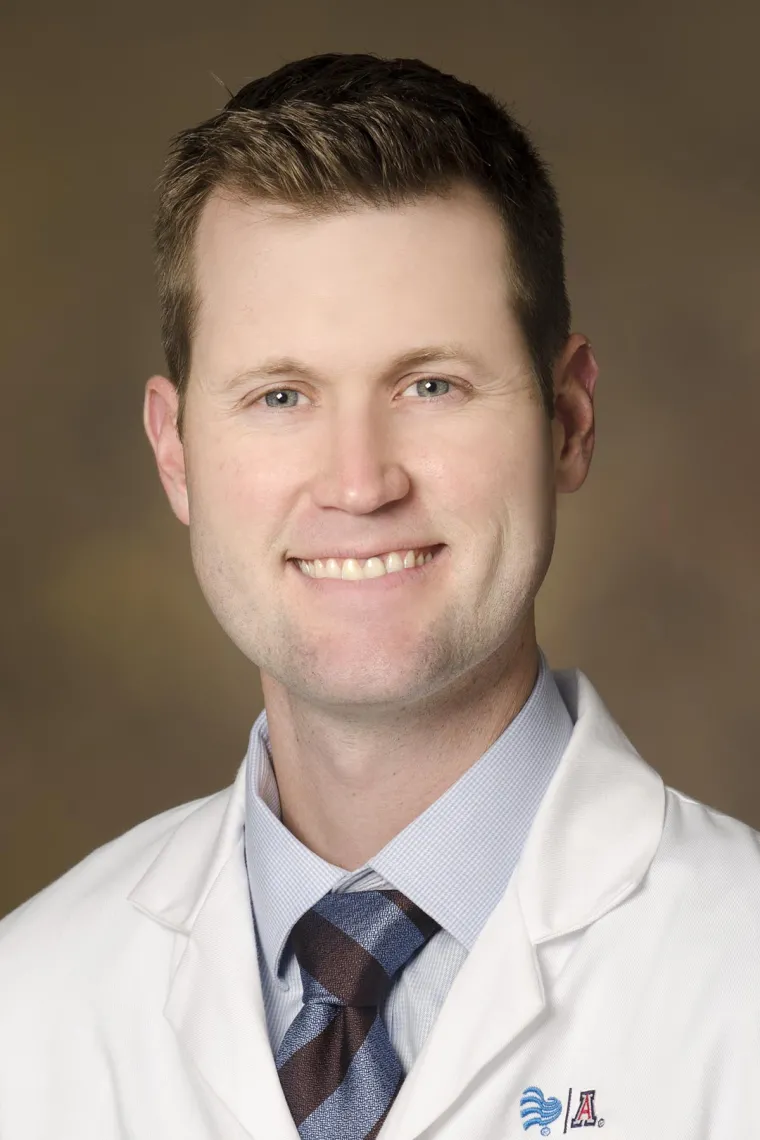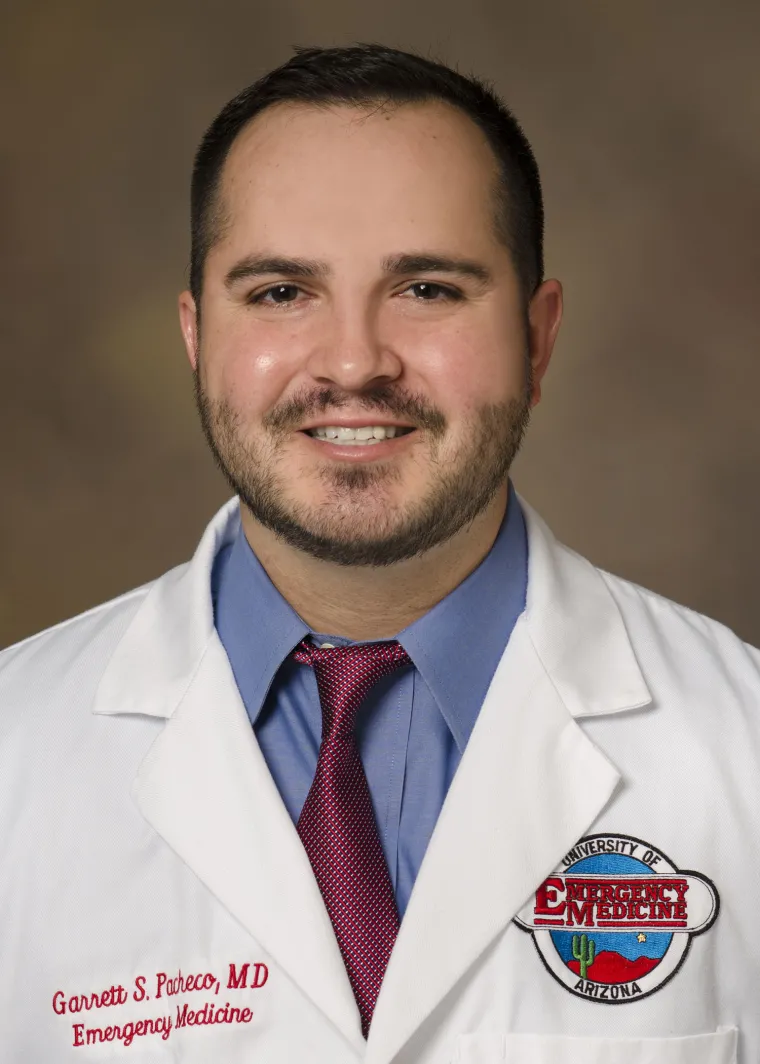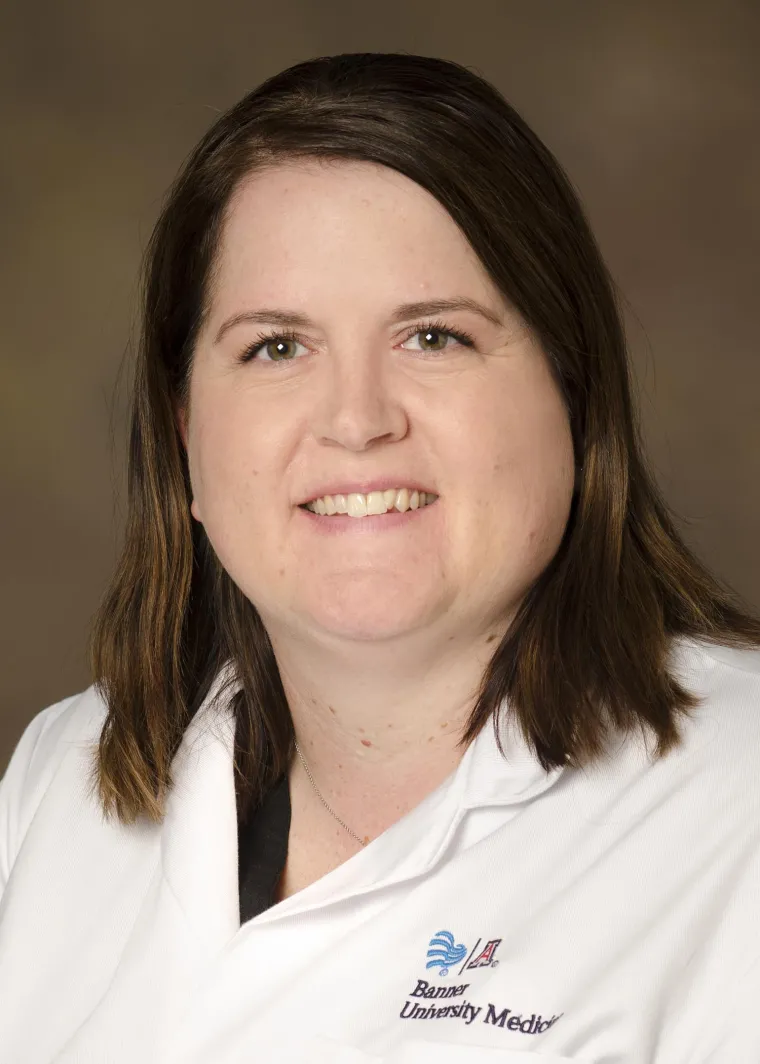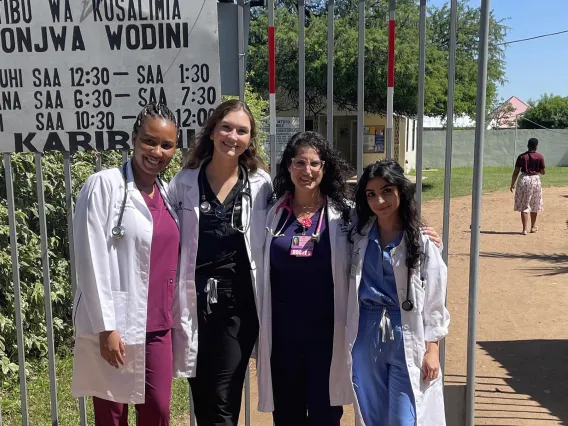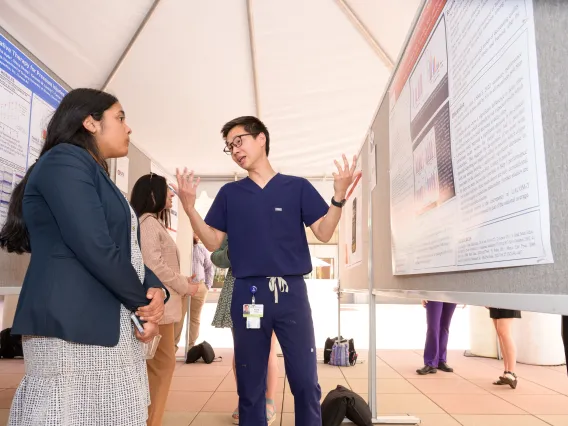Emergency Medicine
Build a Strong Foundation for a Specialized Career
This dual training path offers a streamlined, in-depth foundation, supported by additional resources for career development and specialization in the field.
The Combined Emergency Medicine and Pediatrics Residency Program is a five-year (60-month) ACGME-accredited program that is approved by the American Board of Emergency Medicine and the American Board of Pediatrics. Accepting three residents annually, the program splits training evenly between both specialties, with 30 months dedicated to each. Designed to cultivate physicians who are highly skilled in both emergency care and general pediatrics — with an emphasis on pediatric emergency medicine — the program enables residents to meet all training requirements in a condensed format, completing both specialties in five years instead of six. Graduates are eligible to sit for both ABEM and ABP board certification exams.
Integration is a key strength of the program, as combined emergency medicine and pediatrics residents participate fully in both categorical programs while also developing their own distinct identity. This structure fosters strong community support and a shared learning experience among peers. The program values the uniqueness each resident brings and promotes each individual’s application of combined training toward achieving their personal career goals.
Faculty
Staff
On top of the salary and benefits that all College of Medicine – Tucson residents receive, Combined Emergency Medicine and Pediatrics residents receive additional benefits:
- Individualized dual-board preparation study plans
- Access to Pediatric and Emergency Medicine question banks
- Scrub allowance
- Free parking
- Meal stipend
- Educational stipend
- Mental health services
- Graduate medical education learning and study resources
- High-fidelity simulation training
- Medical Spanish opportunities
- National EM and pediatrics conferences (partially funded)
Certifications and Memberships
- ACLS, ATLS, PALS, NRP, Base Station Physician Course, optional ACLS/BLS Instructor
- Ultrasound certification opportunity
- AAP, AAEM, ACEP and SAEM memberships
EMS
- Ambulance and helicopter ride-along opportunities
- Division 1 sporting event coverage opportunities
Full-Spectrum Clinical Opportunities
- Academic: Banner – University Medical Center Tucson (BUMCT) and Banner – University Medical Center South (BUMCS)
- VA: Southern Arizona Veterans Affairs Health Care
- Community: Tucson Medical Center
- Optional Indian Health Service rotations
- Continuity Clinic: Wilmot, North Hills, optional private practice in senior years
- Critical Care Experience: NICU, PICU, MICU, CV-ICU, VA-ICU, STICU
- Optional global health opportunities (partially funded, plus you don’t lose your salary while you’re gone)
- EM electives (Sports Medicine, Emergency Ultrasound, Wilderness Medicine, etc.)
- Pediatrics electives (Endo, ID, Genetics, HO, Allergy, etc.)
| Name | Graduating Class | Practice Setting | Next Step |
|---|---|---|---|
| Alexandra Barbosa, MD | Class of 2025 | Academic | Location: Johns Hopkins University, Baltimore, Maryland Practice: Pediatric Critical Care Fellowship |
| Shadd Cabalatungan, MD | Class of 2025 | Community | Location: Torrance/Laguna Beach, California Practice: Adult and Pediatric Emergency Medicine |
| Jonathan Coss, MD | Class of 2025 | Academic | Location: Hospital for Special Surgery, New York City Practice: Sports Medicine Fellowship |
| Delaney Fisher, DO | Class of 2024 | Community | Location: Reno, Nevada Practice: Adult and Pediatric Emergency Medicine |
| Eric Kersjes, MD | Class of 2024 | Community | Location: Reno, Nevada Practice: Adult and Pediatric Emergency Medicine |
| Sarah Ring, MD | Class of 2024 | Community | Location: Flagstaff, Arizona Practice: General Emergency Medicine |
| Nathaniel Fox, MD | Class of 2023 | Academic | Location: Tucson Medical Center Practice: Adult & Pediatric Emergency Medicine Roles: Provider |
| Jorge Garcia, MD | Class of 2023 | Community | Location: Santa Clara, California, Kaiser Santa Clara Practice: Adult & Pediatric Emergency Medicine Roles: Provider |
| Jon Violetta, MD | Class of 2023 | Community | Location: Spokane, Washington, Sacred Heart Hospital Practice: Pediatric Emergency Medicine Roles: Provider |
| Rakesh Chopde, MD | Class of 2022 | Community | Location: Rockville, Maryland, Potomac Pediatrics Practice: General pediatric clinic Roles: Provider |
| Anthony Favaloro, MD | Class of 2022 | Community | Location: Covington, Louisiana, St. Tammany Parish Hospital Practice: Adult & Pediatric Emergency Medicine Roles: Provider |
| Riley Fisher, DO | Class of 2022 | Community | Location: Spokane, Washington, Sacred Heart Hospital Practice: Pediatric Emergency Medicine Roles: Provider |
| Hannah Landreth, MD | Class of 2022 | Academic | Location: Tulsa, Oklahoma, St. Francis Hospital Practice: Adult & Pediatric Emergency Medicine Roles: Provider |
| Joshua Glasser, MD | Class of 2021 | Academic | Location: Hershey, Pennsylvannia State University Practice: Adult and Pediatric Emergency Medicine Roles: Assistant Professor of Emergency Medicine and Pediatrics, Emergency Medicine Clerkship Director |
| Jacob Wannemacher, MD | Class of 2021 | Community | Location: New Orleans, Oschner Medical Center Practice: Adult and Pediatric Emergency Medicine Roles: Attending physician |
Curriculum
To meet national guidelines and fulfill the requirements for emergency medicine and general pediatrics board certifications, we have assembled our curriculum to integrate rotations in both EM and pediatrics. Our block grid mirrors the experiences and graduated responsibility of both our categorical EM and categorical pediatric residencies as our residents are functionally EM residents on EM rotations and pediatric residents on pediatric rotations. Together, these experiences culminate in expertise in pediatric emergency medicine.
- Categorical residents promote at the end of each academic year (i.e., Pediatrics level 1 to Pediatrics level 2, EM1 to EM2) once the required rotations for that year are complete. However, combined residents promote only after completing all required rotations in each discipline. This means that combined residents tend to promote to PL2 and EM2 halfway through the second year (18 months of intern-level rotations) and to PL3 and EM3 at the end of the third year (after 18 months of junior-level rotations).
- To integrate the curricula of the two programs, residents will switch every 2-5 months between pediatric and EM rotations. This allows for seasonal variation and prevents gaps in experience between the two programs.
- For the first year, residents split evenly between EM and pediatrics with six-and-a-half blocks each. Thereafter, residents will alternate between 7 EM blocks/6 pediatrics blocks and 6 EM blocks/7 pediatrics blocks.
- Residents will have a pediatric continuity clinic every week while on pediatric rotations, but will not have clinic while on EM rotations.
FAQs
Your options for expert training to take care of children in the emergency department are below with the strengths and limitations listed:
- Peds-PEM (Pediatric residency followed by a pediatric emergency medicine fellowship)
- EM-PEM (Emergency medicine residency followed by a pediatric emergency medicine fellowship)
- EM & Peds (Combined emergency medicine & pediatric residency)
- EM residency followed by pediatric residency or vice versa (two separate residencies)
| Characteristics | Peds Residency PEM Fellowship | EM Residency PEM Fellowship | Combined EM & Peds Residency |
| Duration of Training | 6 years | 5-6 years | 5 years |
| Training Methodology | General pediatric residency with PEM fellowship | EM residency with PEM fellowship | Simultaneous EM and general pediatric residency |
| NRMP Match Cycles | 2 | 2 | 1 |
| Training Focus by Curriculum | Research Pediatric ED | General ED Pediatric ED | General Pediatrics General ED Critical Care |
| Primary Board Eligibility | General Pediatrics | Emergency Medicine | General Pediatrics and Emergency Medicine |
| PEM Sub-Board Eligible? | Yes | Yes | No |
| Trained to care for adults? | No | Yes | Yes |
| Clinic or hospitalist career potential? | Yes | No | Yes |
EM & pediatrics-trained graduates are highly sought-after practitioners because of the breadth of knowledge and skills that they possess. Graduates have opportunities in adult and pediatric emergency departments, pediatric clinics, pediatric hospitalist work and global health. Additionally, graduates are eligible for fellowship opportunities in both pediatrics and emergency medicine.
Of note, Combined EM & Pediatrics Residency graduates are eligible for general pediatrics and the emergency medicine board certification. However, they are not eligible for Pediatric Emergency Medicine subspecialty board certification. This nuance only seems to matter at institutions that feel that the PEM fellowship route is the best training for their system and is variable throughout the country. We have several graduates of the program who work in children’s hospitals and who are on the faculty of PEM fellowships. To date, none of our graduates have required a PEM fellowship after completing the EM & pediatrics residency.
The limited number of combined emergency medicine and pediatrics residency programs in the country makes the programs quite competitive. However, there are fewer applicants who show a true interest in both emergency medicine and pediatrics compared to those who choose one over the other. Therefore, we encourage potential applicants who feel that combined EM & pediatrics training is right for them to consider applying to our program. The University of Arizona Combined EM & Pediatrics Residency provides a complete holistic review of all applications and does not use score cutoffs when considering applicants for interviews.
The first thing we look for when reviewing an application is why you want to do both emergency medicine and pediatrics. This is usually best seen in your personal statement, so take the time to explain your interests, goals, and why you will be a great emergency physician and a great pediatrician. In addition, we value the uniqueness that you will add to our program, your wellness in Tucson and within the residency, and the clinical and academic excellence you have shown throughout your training.
All EM & pediatrics program directors recommend that potential applicants choose either categorical emergency medicine or categorical pediatrics or both as a backup due to the limited number of combined EM & pediatrics spots in the country. Because of this, we recommend strengthening your application toward whichever categorical program you choose. Just be sure you include why you want both in your application.
Most everyone will end up doing a pediatric rotation and an EM rotation. These are important to secure pediatric and emergency medicine letters of recommendation.
We would also recommend either a pediatric ICU or pediatric ED elective if possible. These are certainly not necessary, but both rotations are relevant to categorical EM and categorical pediatric residencies and certainly relevant to EM & pediatrics. We offer these rotations at the University of Arizona through VSAS.
Please note that our visiting student slots are limited and, therefore, competitive. If you are not granted a spot, please do not take this as an indication of your competitiveness for the program. We just have very limited spots available to non-U of A students.
The Lore of the Pink Scrubs
The Combined EM & Pediatrics Residency Program was started in 2005 by Dr. Dale Woolridge, who trained at the EM & Pediatrics Residency Program in Baltimore and brought with him two traditions:
- A Halfway Party, celebrating the 2.5-year mark in a combined resident’s five-year program
- A pair of pale pink shock-trauma scrubs that he was fond of wearing here in Tucson

In 2008, he gave a set of pale pink scrubs to his second class at their Halfway Party (the first class refused to wear them because they looked like they were stained with Pepto-Bismol). This began the tradition of giving pink scrubs to the EM & pediatrics residents at their Halfway Party. The pink scrubs represent the EM & pediatrics senior residents and are known throughout the hospital to identify some of the most experienced, skilled and versatile residents. Each year both the pediatrics and emergency medicine programs look forward to the Halfway Party and to celebrating the achievements of our EM & pediatrics residents.
How to Apply
The University of Arizona College of Medicine — Tucson Combined Emergency Medicine Residency Program accepts applications for PGY1-level positions only. This program participates in the National Resident Matching Program.
Our program uses ResidencyCAS for the application process with a deadline for receipt of materials of December 1. Please note: Locally we refer to our program as the University of Arizona EM&Peds Program, but the official ACGME name you will find on ResidencyCAS, NRMP and FREIDA under the heading Pediatrics/Emergency Medicine as the University of Arizona College of Medicine — Tucson Program.
Make sure you include:
- Medical Student Performance Evaluation (dean’s letter)
- Medical school transcript
- Three current letters of reference
- One letter, ideally from an emergency physician, attesting to the candidate’s aptitude for emergency medicine using either the SLOE or O-SLOE format.
- SLOE: A standardized letter of evaluation (SLOE) according to the Emergency Medicine Council of Residency Directors format is preferred, if possible.
- O-SLOE: If your school does not offer an emergency medicine rotation or you cannot obtain a SLOE, an off service standardized letter of evaluation may be substituted;
- USMLE Step 1 score or COMLEX Level 1 score (and USMLE Step 2 when completed)
- One letter, ideally from an emergency physician, attesting to the candidate’s aptitude for emergency medicine using either the SLOE or O-SLOE format.
Interviews for residency positions will be granted by invitation only after reviewing your completed application. Our interview season typically runs from mid-November through the end of January. We will be sending out invitations to interview on a rolling basis.
The first wave of invitations will be sent out in mid-October. Further invitations will be sent out as needed until all of our interview slots are filled.
Communication regarding final status (selected to interview, placed on wait list or decline to interview) will be sent by December 19, 2025.
Application to and ranking for the University of Arizona Combined EM & Pediatrics Residency Program is kept separate from that of the categorical EM program and the categorical pediatrics program. Applicants will be offered an EM&Peds interview day where they will interview with program leadership and faculty from the EM, pediatric and combined EM&Peds programs. This interview will discuss aspects of all three residency programs with a focus on how EM&Peds is integrated into both categorical programs. Applicants will have the opportunity to attend EM and Pediatric Q&A sessions as well as to meet with EM, pediatric and EM&Peds residents to share experiences from the training programs.
For those applying to both the combined and categorical programs, the EM&Peds interview day will count toward all three programs. However, you must apply to each program individually to be considered for ranking. A concurrent application to the combined program or categorical program will in no way benefit or compromise the other and vice versa. Recruitment and ranking for the two programs are kept separate.
University Campus EM Residency Program Pediatrics Residency Program
Training in Tucson

Learn more about the residency and fellowship programs at the College of Medicine – Tucson.
Contact


